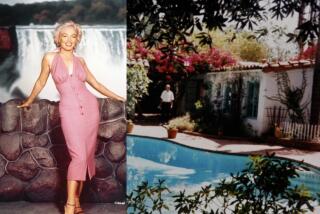Historic Area Shines After Renovation
Two historic buildings and the streets surrounding El Pueblo de Los Angeles Historical Monument--the birthplace of Los Angeles in 1781--reopened Friday after six months of renovations and repairs.
“El Pueblo, our city’s birthplace, is more than a monument,” said Mayor Richard Riordan to a crowd of city and state leaders and Olvera Street merchants. “It is Los Angeles history.”
The renovations included the opening of the once-deteriorating Pico House, the first three-story building in the city of Los Angeles. The structure, built in 1869-70 by Pio de Jesus Pico--the last governor of California when it was part of Mexico--underwent seismic strengthening and exterior renovations, which included a gray and maroon paint job.
The Hellman Quon Building, next to the oldest firehouse in the city, was also opened.
The surrounding streets--Main, Sanchez and Los Angeles--received lighting, new trees and cobblestone walkways.
A timeline of the city’s history will be added along Sanchez Street, said Jean Bruce Poole, director of the historical museum since 1977.
Work began on the seven-building, two-block area, known as the Pico-Garnier block, in January by the city’s Department of General Services, the Bureau of Lighting and the Department of Transportation. Funding for the $25-million project came partly from Proposition G, which made the seismic strengthening possible.
Merchants at the adjoining Olvera Street shopping area said Friday that they are pleased with the face lift. Merchants have suffered from decreased sales since construction began in January, with many seeing a 20% to 35% drop during the time.
Mike Mariscal, owner of My Rosa Enterprises, which specializes in selling trinkets such as pottery, T-shirts and other goods, said the new lighting and landscaping have made the plaza area safer and cleaner, which he feels will attract larger crowds, including party functions.
Mariscal’s family “has been through the good times and the bad times” since coming to Olvera Street. His great-grandparents were among the original merchant families along Olvera Street, created in the 1930s as a living replica of a Mexican village market street, complete with about 80 restaurants, stalls and shops.
“Hopefully we can compete with other tourist attractions” such as the Santa Monica Pier and Universal CityWalk, said Peter Martinez, owner of Margarita’s Gifts.
However, many shop owners, including Mariscal and Martinez, are afraid that the second phase of renovations, which includes work in the Olvera Street shopping area, may lead to further revenue losses.
“We’re not against it, but we are just concerned about the process,” Martinez said. Owners believe that the second phase of construction may take longer and may require business owners to close for some time, he said.
But the completion of this first phase was a good start, they said. The opening was commemorated with the blessing of the four corners of the El Pueblo Plaza, with a number of white doves taking flight and a mariachi band playing a song of victory.
The opening comes at a time when sales are expected to increase because of the mass of visitors arriving in the city for the Democratic National Convention next week.
Sometime in 2001, the city hopes to complete renovations to other parts of the historic sector, including the Merced Theater and the Garnier Building, Poole said.
More to Read
Sign up for Essential California
The most important California stories and recommendations in your inbox every morning.
You may occasionally receive promotional content from the Los Angeles Times.










